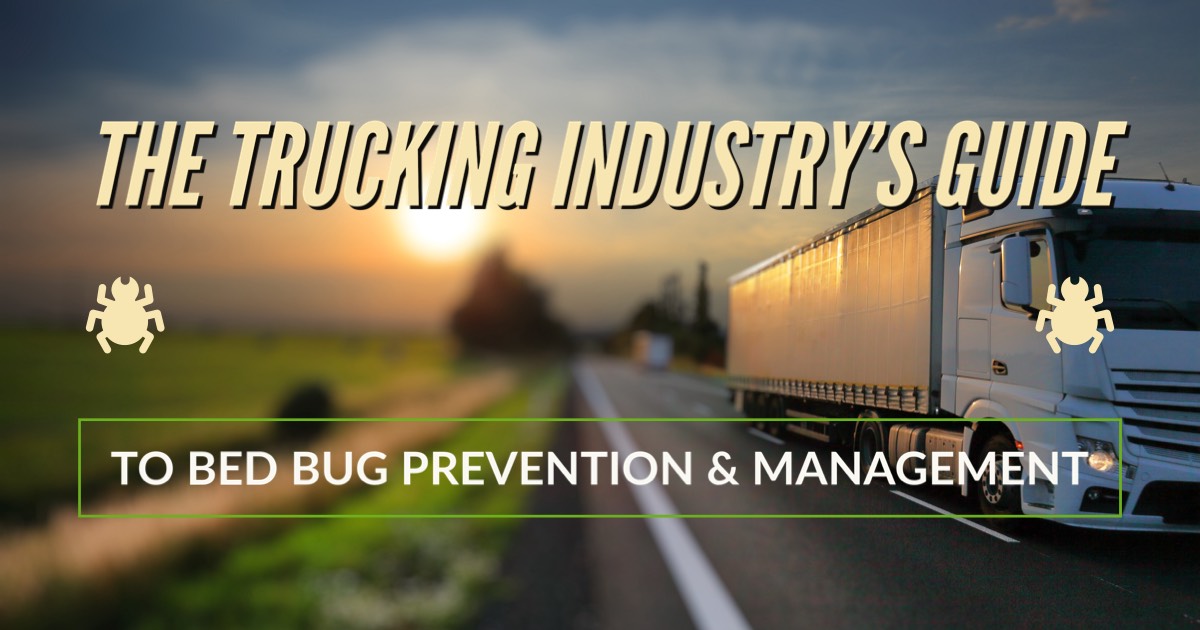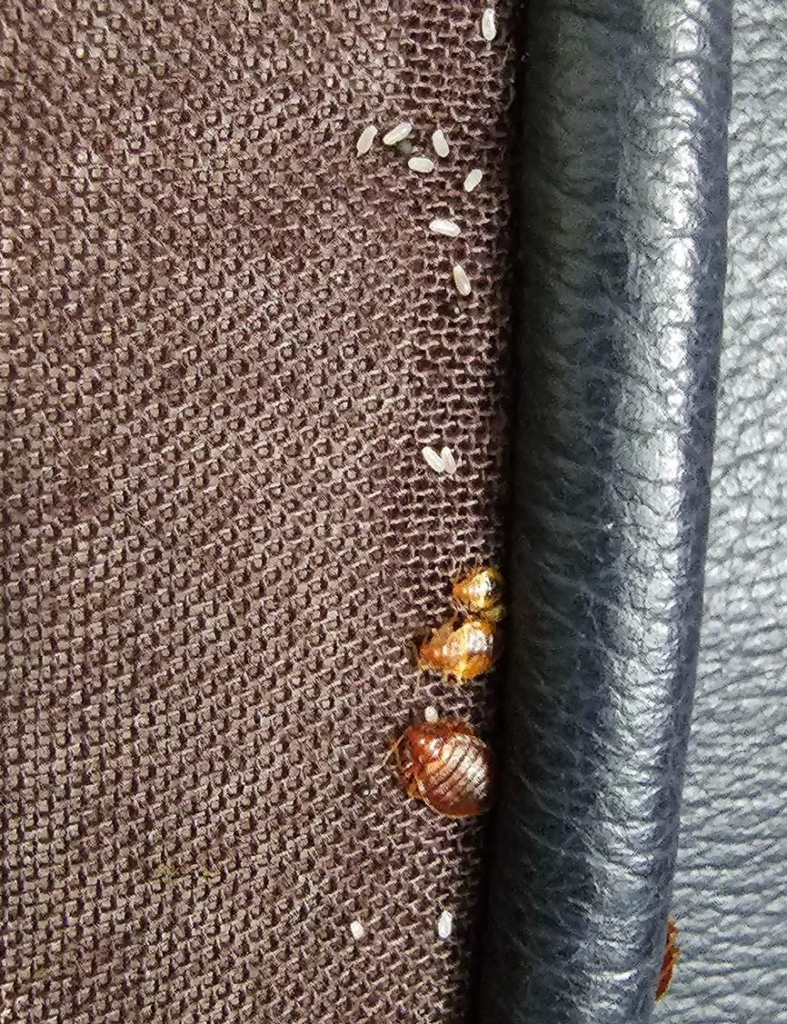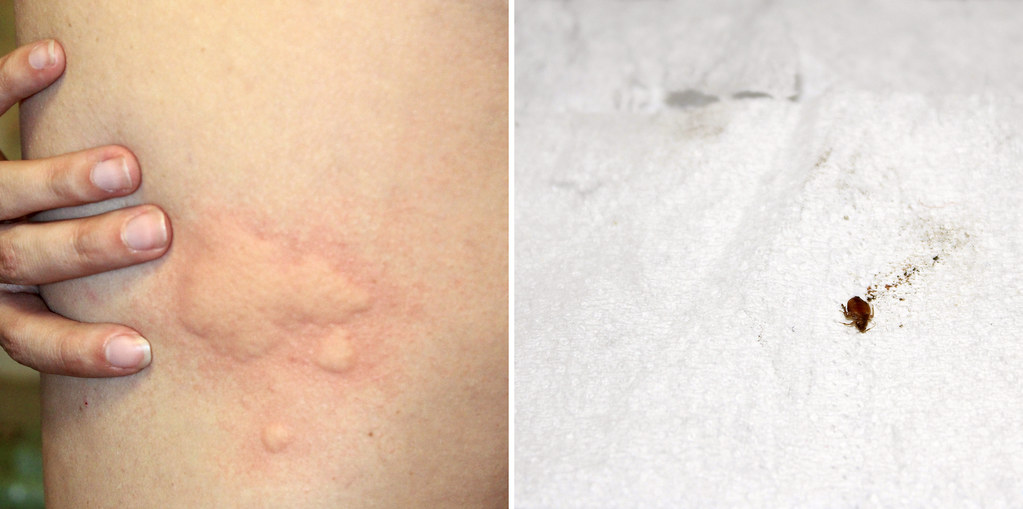The Trucking Industry’s Guide to Bed Bug Prevention and Management

Introduction
Working as pest control operators in the bed bug industry, we have received dozens of calls from trucking companies about drivers facing issues with bed bugs while on the road and in between routes. These issues have many impacts on drivers, trucking companies, and the logistics of moving freight. Not only can drivers face health-related issues and psychological impacts after exposure to bed bugs, but trucking companies and other stakeholders in the industry face great economic impacts. Early awareness and education is important to prevent the spread of bed bugs for drivers and trucks. Drivers need to learn how to inspect for bed bugs and what to do should they encounter them, and companies will learn how to establish protocols to avoid costly downtime. In this guide, we will go over bed bug basics, the risks to drivers and trucks, best practices for prevention, and much more.
Bed Bug Basics
First off, what are bed bugs? Bed bugs are small, reddish-brown, flat, oval-shaped, parasitic insects that spread very easily and feed on humans or animals to survive. Bed bugs have several stages from egg to nymph before they become adults, making them difficult to see at first. According to the University of Florida, adult bed bugs can survive 6-7 months without feeding.
An adult bed bug is roughly the size of an apple seed and visible to the naked eye. Bed bugs tend to feed at night and usually live close to their host. Studies show that bed bugs are attracted to human odors. A common misconception is that they are nocturnal, however, they can come out to feed at any time. Although bed bugs are not known to spread diseases, they can cause allergic reactions and psychological and economic harm.

Common Signs of a Bed Bug Infestation
Once you know what to look for, there are many ways to help identify potential bed bug infestations. At first, some people may notice unexplainable rashes which may be an initial sign of possible bed bugs, however, this is not a reliable way to determine that you have an infestation as not everyone may be allergic and the rashes may take time to develop. The most reliable way to confirm bed bugs is by finding a live adult or any bed bug in its infant stages. At this point, bed bugs are confirmed and you should consult with a professional and take immediate action. Other signs to look for are unusual small reddish-brown stains on sheets, blankets, or pillowcases. You may also notice a sweet-musty-like smell. Further signs are finding bed bug fecal matter, exoskeletons, or eggs in the seams of mattresses and other areas they may hide.
Risks for Truck Drivers
Truck drivers are at greater risk than the average individual when it comes to the spread of bed bugs. Anyone who frequently travels is more at risk, and truck drivers often travel long distances staying in various accommodations and thus increasing their chances of coming into contact with bed bugs. Trucking often requires tight logistics and drivers may not have time to thoroughly inspect and clean the truck, their clothes, and where they sleep. The other key element that gives drivers greater risk is the fact that they are constantly staying in shared spaces. Whether it is the truck that is shared by other drivers, or motel rooms and truck stops that have high turnover from other frequent travelers, truckers need to be aware of their risks. Motels and truck stops are often known to experience bed bug infestations and play a role in the spread of bed bugs for truck drivers. They experience a great deal of turnover among guests and increase the likelihood of bed bugs being introduced and spread. Drivers are constantly on the go at these locations and that also decreases awareness and increases risk. Since bed bugs are known to hide in bedding and furniture, constantly using shared bedding and furniture further increases the risk of transmission. Finally, because of the high frequency of guest turnover, places like motels and truck stops may have inadequate pest control inspections and measures.
Inspection Tips for Truck Drivers and Trucking Companies
Cabin Components: Inside the cabin and its components, regularly check seams, folds, and crevices of seats for bed bug hiding spots. Inspect the dashboard, steering wheel, and other components for any signs.
Sleeping Area: In the sleeping area, remove bedding and thoroughly inspect the mattress seams and folds. Check curtains, upholstery, and carpeting for bed bug activity. Pay special attention to any storage areas within the sleeping space. After each route, bedding (sheets, blankets, pillowcases) should be stripped, washed, and dried on a high-heat cycle.
Live Bed Bugs: Actively look for live bed bugs in and around the inspected areas. Use a flashlight to illuminate dark corners and crevices.
Fecal Stains: Look for small reddish-brown or black stains, indicative of bed bug fecal matter.
Fecal stains may be present on bedding, upholstery, or other surfaces.
Shed Exosleletons: Check for translucent, empty exoskeletons left behind by molting bed bugs. These can often be found near their hiding spots.
Musty Odor: Pay attention to any unusual, musty odors in the truck cabin, which may indicate a significant infestation.
Blood Stains: Examine bedding and upholstery for small blood stains resulting from bed bug feeding.
Egg Casings: Look for small, white, or translucent egg casings in and around potential hiding spots. Regular and thorough inspections using these steps can help truck drivers identify and address potential bed bug issues promptly, preventing infestations from spreading further.
What to Do If Bed Bugs Are Suspected in the Truck?
Do Not Panic: It is important to stay vigilant and not make bad decisions. Do not go stay elsewhere with your belongings as you can easily transfer the bed bugs to a hotel or your home. Do not buy pesticides from the store and attempt to self-treat the cabin as you can potentially misuse pesticides and make the situation worse or harm your health.
Notify Management: Notify the company and let them know what you suspect. If you’re on the road, you can stop to vacuum, clean, and bag up your belongings until you get back. Management should help you come up with a plan to either treat the vehicle while on the road or when you return.
Clean the Vehicle: If you see live bed hugs, you can use a napkin to crush, remove, and throw them away. Take the time to vacuum and clean the cabin at the next truck stop. You can use sanitizing wipes to wipe down surfaces.
Bag Up Belongings and Launder: Stop and purchase a box of garbage bags. If you don’t have time to launder your items, double bag them and tie them tight until you get a chance to. Make sure you do this before going home or into a motel. If you have time to launder your items on high heat, place them into clean and new garbage bags and keep them sealed up while in the vehicle to prevent cross-contamination of your items. You should also do this with your sheets, blankets, and pillowcases if you will continue to be on the road until you return to your company’s location.
Inspection Tips for When Truckers Stay in Motels or Hotels
Mattress Seams and Folds: Thoroughly examine mattress seams and folds for live bed bugs and fecal stains. Lift and inspect the mattress at the seams and edges.
Bedding: Inspect sheets, pillowcases, and blankets for any signs of bed bug activity. Pay attention to seams and corners where bed bugs may hide.
Headboard and Bed Frame: Check the headboard and bed frame for live bed bugs, fecal stains, or shed exoskeletons. Examine seams, joints, and any cracks in the furniture.
Chairs and Couches: Inspect upholstery on chairs and couches thoroughly, focusing on seams and folds. Check for signs of bed bug activity in cushions and along the edges.
Towels and Linens: Inspect towels and linens for any signs of bed bugs or their fecal stains. Check seams and folds of towels and washcloths.
Cracks and Crevices: Examine bathroom tiles, baseboards, and any cracks or crevices where bed bugs could hide.
What to Do If Bed Bugs Are Suspected in a Motel Room?
Notify Management: Immediately inform motel management if you suspect bed bugs. Provide details of your observations and request a room change.
Document Evidence: Take clear photos or videos of any signs of bed bugs in the room. Document the date and time of your discovery for reference.
Request Professional Inspection: Ask motel management to conduct a professional inspection by a licensed pest control professional. Request information on their bed bug treatment and prevention protocols.
Protect Your Belongings: Keep luggage elevated and away from beds and upholstered furniture. Consider using bed bug-proof encasements for luggage and personal items. Before checking out or getting back into the truck, consider laundering your belongings in the dryer in a high-heat cycle and placing them into garbage bags. If there is no washer/dryer on-site, consider bagging up the items in garbage bags and tightening them up until you can.
Consider Alternative Accommodations: If bed bugs are confirmed, consider moving to a different motel or lodging establishment. Ensure that the new accommodation has undergone proper bed bug inspection and treatment. Regular and thorough inspections, coupled with prompt action if bed bugs are suspected, will help you avoid potential infestations while staying in motels.
Establish Best Practices and Reporting Protocols
Truck drivers and owners should establish protocols for regular inspections. Vacuuming and cleaning the cabin regularly is also very important. Consider establishing a system or checklist using the best practices from this guide for when on the road and when trucks return to the yard.
Early Intervention and Mitigation: Reporting suspected bed bug infestations promptly allows for early intervention and mitigation efforts. Swift action can prevent the spread of bed bugs and minimize the impact on the truck driver’s health and well-being.
Preventing Infestation Spread: Timely reporting is crucial to prevent the inadvertent spread of bed bugs to other areas, including other truck stops, motels, or even the driver’s home. It facilitates a targeted response to contain and eliminate the infestation at an early stage.
Protecting Fellow Truckers and the Company: Reporting benefits the entire trucking community by protecting fellow truckers from potential exposure to bed bugs. It contributes to a shared responsibility for maintaining cleanliness and also prevents downtime and economic loss.
Trucking Company Procedures: Familiarize yourself with your trucking company’s specific procedures for bed bug issues. If you don’t have any, implement them as soon as possible. You can use this guide to do so. Ensure you have access to contact information for the appropriate personnel responsible for handling pest-related concerns. Establish emergency hotlines or contacts readily available for immediate reporting of severe bed bug incidents.
Conclusion
Not only can bed bugs cause distress for drivers while on the road, but there are great economic consequences to the industry as a whole. Trucking companies can face significant downtime if a truck needs to be treated for bed bugs and in some cases, they can face a public relations crisis if the words get out. By implementing these best practices, companies can avoid downtime and costly treatments. Drivers can prevent possible health and psychological distress while on the road. It is important to also set up a plan with a professional to regularly inspect or treat your vehicles.


